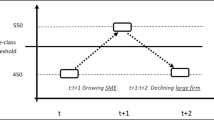Abstract
This paper analyses the importance of entrepreneurs in terms of job creation and wage growth. Relying on unique data that cover all establishments, firms and individuals in the Danish private sector, we are able to distil a number of different subsets from the total set of new establishments—subsets which allow us to more precisely capture the “truly new” or “entrepreneurial” establishments than has been possible in previous studies. Using these data, we find that while new establishments in general account for one-third of the gross job creation in the economy, entrepreneurial establishments are responsible for around 25% of this, and thus only account for about 8% of total gross job creation in the economy. However, entrepreneurial establishments seem to generate more additional jobs than other new establishments in the years following entry. Finally, the jobs generated by entrepreneurial establishments are to a large extent low-wage jobs, as they are not found to contribute to the growth in average wages.

Similar content being viewed by others
Notes
See also Storey (1991) for an earlier discussion of the problems in identifying the “wholly new firms” among the set of new or entrant firms.
Note that we exclude all establishments that belong to these industries in at least 1 year.
By “same employees” is meant that at least 30% of the employees should be present in both years.
van Stel and Storey (2004) have previously used new registrations for VAT as a measure of firm births.
For example, adding 23% to job creation by TNF establishments in 1999 while reducing job creation by new establishments by 4% (as suggested by the 2-year ahead measures in the lower part of Table 5) can raise the share of TNF establishments in job creation by new establishments from the 15.6% reported in Table 4 to 20%. This in turn could raise their share in total job creation by 1–2 percentage points.
In this section, employment is measured as the number of fulltime equivalent workers.
References
Albæk, K., & Sørensen, B. (1998). Worker flows and job flows in Danish Manufacturing, 1980–91. Economic Journal, 108, 1750–1771.
Audretsch, D. B., & Fritsch, M. (2002). Growth regimes over time and space. Regional Studies, 36, 113–124.
Bartelsman, E., Haltiwanger, J. C., & Scarpetta, S. (2004). Microeconomic evidence of creative destruction in industrial and developing countries. IZA Discussion Paper No. 1374. Institute for the Study of Labor (IZA), Bonn
Birch, D. L. (1979). The job generation process. Cambridge, MA: The MIT Programme on Neighbourhood and Regional Change.
Birch, D. L. (1987). Job creation in America: How our smallest companies put the most people to work. New York: Free Press.
Brixy, U., Kohaut, S., & Schnabel, C. (2007). Do newly founded firms pay lower wages? First evidence from Germany. Small Business Economics, 29, 161–171.
Brown, C., & Medoff, J. L. (2003). Firm age and wages. Journal of Labor Economics, 21, 677–697.
Davis, S. J., & Haltiwanger, J. C. (1992). Gross job creation, gross job destruction and employment reallocation. Quarterly Journal of Economics, 107, 819–863.
Davis, S. J., Haltiwanger, J. C., & Schuh, S. (1996a). Job creation and destruction. Cambridge: MIT Press.
Davis, S. J., Haltiwanger, J. C., & Schuh, S. (1996b). Small business and job creation: Dissecting the myth and reassessing the facts. Small Business Economics, 8, 297–315.
Dunne, T., Roberts, M., & Samuelson, L. (1989). The growth and failures of U.S. manufacturing establishments. Quarterly Journal of Economics, 104, 671–698.
Foster, L. S., Haltiwanger, J. C., & Krizan, C. J. (2001). Aggregate productivity growth: Lessons from microeconomic evidence. In E. Dean, M. Harper, & C. Hulten (Eds.), New developments in productivity analysis. Chicago: University of Chicago Press.
Fritsch, M., & Mueller, P. (2008). The effect of new business formation on regional development over time: The case of Germany. Small Business Economics, 30(1), 15–29.
Iversen, J., Jørgensen, R., & Malchow-Møller, N. (2008). Defining and measuring entrepreneurship. Foundations and Trends in Entrepreneurship, 4, 1–63.
Klette, T. J., & Mathiassen, A. (1996). Job creation, job destruction and establishment turnover in Norwegian manufacturing. Annales d’Économie et de Statistique, 41/42, 97–125.
Mueller, P., van Stel, A., & Storey, D. J. (2008). The effects of new firm formation over time: The case of Great Britain. Small Business Economics, 30(1), 59–71.
Neumark, D., Zhang, J., & Wall, B. (2006). Where the jobs are: Business dynamics and employment growth. Academy of Management Perspectives, 20, 79–94.
Neumark, D., Wall, B., & Zhang, J. (2008). Do small businesses create more jobs? New evidence from the national establishment time series. NBER working paper no. 13818. National Bureau of Economic Research (NBER), Cambridge.
Oi, W. Y., & Idson, T. (1999). Firm size and wages. In O. Ashenfelter & D. Card (Eds.), Handbook of labor economics (Vol. 3, pp. 2165–2214). Amsterdam: Elsevier Science.
Parker, S. C. (2004). The economics of self-employment and entrepreneurship. Cambridge: Cambridge University Press.
Spletzer, J. (2000). The contribution of establishment births and deaths to employment growth. Journal of Business and Economic Statistics, 18, 113–126.
Statistics Denmark. (2002). Tilgang af Nye Virksomheder. København: Danmarks Statistik.
Storey, D. J. (1991). The birth of new firms—Does unemployment matter? A review of the evidence. Small Business Economics, 3, 176–178.
van Stel, A. J., & Storey, D. J. (2004). The link between firm births and job creation: Is there a upas tree effect? Regional Studies, 38, 893–909.
van Stel, A., & Suddle, K. (2008). The impact of new firm formation on regional development in the Netherlands. Small Business Economics, 30(1), 31–47.
Acknowledgements
We thank the National Agency for Enterprise and Housing for financial support for this project. Sørensen also gratefully acknowledges financial support from Tuborgfondet.
Author information
Authors and Affiliations
Corresponding author
Rights and permissions
About this article
Cite this article
Malchow-Møller, N., Schjerning, B. & Sørensen, A. Entrepreneurship, job creation and wage growth. Small Bus Econ 36, 15–32 (2011). https://doi.org/10.1007/s11187-009-9173-y
Received:
Accepted:
Published:
Issue Date:
DOI: https://doi.org/10.1007/s11187-009-9173-y




